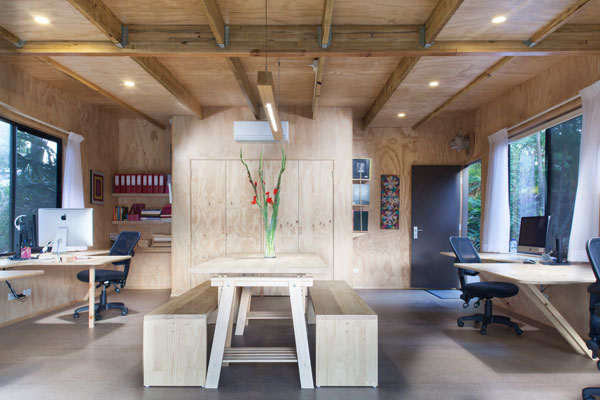For POMO’s new studio, Creative Director Stephen Burton envisioned a sustainable, inspirational and creative workspace that would be complimentary to the old-growth trees and forest in which it would be built.

December 9th, 2014
Sustainability was central to the design. The site, in Rosemount, Sunshine Coast hinterland, was on the side of a very steep hill and in a corridor of old trees and it was very important to Burton that none of this environment would be harmed.
As a term often used, even over-used, and sometimes misunderstood, we ask Burton what sustainability means to him and to this project. How did the bid ‘to be sustainable’ eventuate and how does it effect their working environment.
“I always thought sustainability was a worthy aspiration but something only achievable by scientists, environmentalists and others ‘in the know’. I was dead wrong. When I set out to create a new studio for my design agency I aspired to create something sustainable but must admit that cost quickly became a key concern. However, I was amazed to discover that in selecting the most raw, stripped back, basic building materials for our studio I was, at the same time, choosing the most sustainable and the most cost effective options.
Now the space is completed and we have been working inside it for about a year, being surrounded by raw plywood, carpet-less floors, LED lighting and lots and lots of glass has made a real impact on our working day. It feels great to be in a space that’s connected to nature – not hidden behind layers of manufactured products like paint, carpet or gyprock. This has in turn had a positive impact on our work, our collaboration in the office and consequently on the business as a whole. Sustainability, creativity, nature, collaboration, positivity, it’s all wound up together, part of the same whole, as it’s meant to be. That’s the natural order of things.”
Using expansive floor to ceiling glass corners and custom made sliding doors, the office has an open, tree-house feel, the doors opening to a viewing deck that stands over 6m high from the bush floor and “quite literally in some of the tree tops”.
Positioned as it is, the studio relies almost entirely on natural resources for ventilation and heating and being located at the top of a valley on the Sunshine Coast, “we attract the afternoon sea breeze with cross-flow ventilation,” says Burton.
“The natural canopy of the close trees prevent direct summer sun and therefore help lower our cooling bills while heating in winter is virtually unnecessary as the aspect of the building allows the sun to stretch into our studio space in the cooler months.”
The studio’s sustainable features are throughout too. The floor uses manufactured timber support beams rather than hardwood, made from sustainable plantation timber, and is exposed yellow tongue flooring – which is made from a high recycled material component. For the roof, timber beams made from sustainable pine plantations which are grown locally are used, and it is lined with plywood also made from sustainable pine plantations. The walls are the same, as is the furniture (aside from the office chairs), and no paint is used inside the building.
Instead of emptying water from gutters, an area above the front deck creates a waterfall to return water to the forest floor. Throughout, LED lighting reduces power consumption and the space is fully insulated and with the advantage of a north aspect to use winter sum to heat the building but excluding summer sun and make the most of the natural canopy of trees for shade and cooling.
And as Burton tells us, sustainability doesn’t stop at energy consumption. The furniture, including a custom-made park bench style meeting table and free flowing fully connected plywood workspaces, makes for a work environment that is inspiring. “Creatively,” Burton says, “the space is very conducive to open communication and collaboration. For a creative business the sharing of ideas and inspiration has improved our collective output and our focus”.
If the original intention was “to create something that was respectful of and appropriate for the space in which it was located,” they’ve succeeded. The tree-house like office fits quietly in the old forest it sits in and doing so, inspires creative thinking and design amongst the staff.
Photography: Lucas Muro
The studio was the brain-child of POMO’s Creative Director Stephen Burton.
Builders: Tim Coates and Callum Fraser
Kind of project: new build
Location: Rosemount, Sunshine Coast hinterland
Parameters of project: Open plan 42 sqm creative studio workspace
Date of project completion: November 2013
POMO
pomo.com.au
A searchable and comprehensive guide for specifying leading products and their suppliers
Keep up to date with the latest and greatest from our industry BFF's!

Within the intimate confines of compact living, where space is at a premium, efficiency is critical and dining out often trumps home cooking, Gaggenau’s 400 Series Culinary Drawer proves that limited space can, in fact, unlock unlimited culinary possibilities.

To honour Chef James Won’s appointment as Gaggenau’s first Malaysian Culinary Partner, we asked the gastronomic luminaire about parallels between Gaggenau’s ethos and his own practice, his multidimensional vision of Modern Malaysian – and how his early experiences of KFC’s accessible, bold flavours influenced his concept of fine dining.

In the age of the social influencer, we believe it’s your design actions that define you as a game-changer. Here are three celebrated projects from the 2018 INDE.Awards that have positively impacted people’s lives.

DesignByThem’s newest release leans into nostalgia to create a chair that’s simultaneously playful and practical.
The internet never sleeps! Here's the stuff you might have missed

As the cultural footprint of F1 expands, so too does the Ferrari presence beyond the track – and it’s taking the form of highly refined spaces of design.

Kerrie Shepherd is a Kamilaroi woman and Principal of Connecting with Country at Aboriginal-owned urban design company Yerrabingin, drawing on extensive lived experience with First Nations communities.